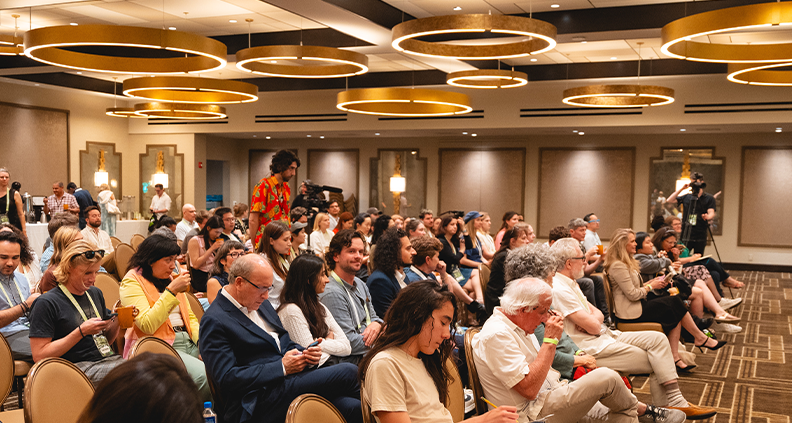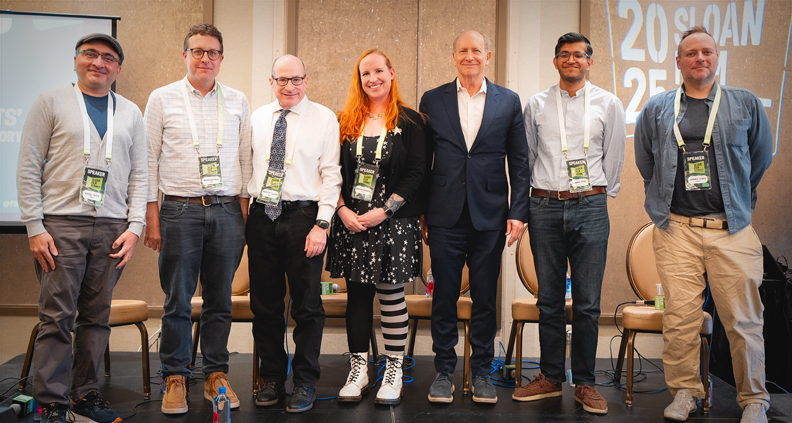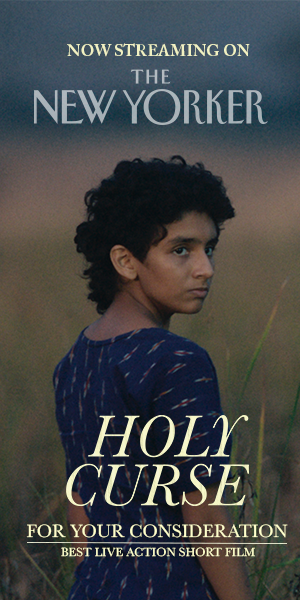MAKING IT FEEL REAL: Scientific Consultants Panel at Sloan Summit
In a power-packed weekend of seminars, panels and pitch sessions, hundreds of filmmakers gathered from the four corners of the earth (technical term) to celebrate the Alfred P. Sloan Foundation’s pioneering science and technology film program.
On Saturday afternoon, Film Independent assembled a panel of science consultants and storytellers to explore the delicate balance between technical accuracy and effective storytelling. What’s it like to consult on a show or a movie?
Maybe not as uppity and exacting as we might expect.
“We’re not the science police,” commented David Saltzberg (The Big Bang Theory), “it’s their story.” Saltzberg embraces his supporting role as a noticer of inconsistencies and a suggester of solutions – as do the four other science experts joining him on the panel moderated by IndieWire writer and critic, Ritesh Mehta.
From Star Trek to The Resident, read on for a fun peek behind the curtain of “[insert science here]” and the people who fill the space between brackets.
THE CREATIVE PROCESS
So how does one go about translating theoretical physics for general audiences? Do you have to have a whiteboard?
The Big Bang Theory has three. “There were about three whiteboards on the walls in 279 episodes,” Saltzberg recalled. “Every one had to be filled with science.” Producer David Goetsch explained the “really brilliant process” they had of writing “[science to come]” in the scripts the writers sent to Saltzberg.
Saltzberg was imaginative about what science he provided; for whiteboard equations, he considered visual interest as well as current events in the world of science. Mainly he took the story into account; if Leonard and Sheldon were going to write on a whiteboard, it’s because they had been discussing it. Maybe not in the scene, but just before.
Now and then a conflict arose between actual science and the story that the writers wanted to tell. Saltzberg referenced an episode where Leonard’s mother was working with Sheldon on Quantum Brain Dynamic Theory, “which made sense because she was a neuroscientist and he was a quantum particle physicist. The problem is a lot of scientists don’t take that theory very seriously – but they’d already written so much and I felt so bad.”
Saltzberg mentioned it and moved on, but the next draft he received had clearly taken his notes to heart – now the episode was about disproving Quantum Brain Dynamic Theory.
AUTHENTIC REPRESENTATION
Astrophysicist Erin Macdonald (Star Trek) recounted a more mixed result to one run-in with science and storytelling. “In season four of Star Trek Discovery, they wanted to have a plot where they have to ride the gravitational waves out of this anomaly. Gravitational waves don’t work that way – and that’s okay, but it was a cool idea!”
Being the topic for her PhD, Macdonald was intrigued to see gravitational waves featured in Star Trek. So a scene was written and filmed in the ready room, explaining how this escape tactic would work – with the starship surfing the waves to freedom.
Macdonald worked with the motion graphics teams to clarify that these waves are more like sound waves than ocean waves. “To their credit, they redid the whole scene with the sound compression waves in there. And then we all watched it … it just didn’t work for what they were talking about, and it would throw the audience.”

Rather than mess with the viewer’s sense of riding waves, Macdonald encouraged the team to stick with their original concept – and face the consequences from her colleagues.
“It’s fine,” she said. “I’m fine.”
Practicing oncologist Roshan Sethi (The Resident) was very focused on accuracy when he first began consulting. “I’ve since crossed over, and I now mainly do screenwriting and directing. And when my work occasionally does touch medicine, I am cavalier in being accurate! My priorities have all shifted.”
By his own admission, Sethi is happy to trade fastidious accuracy for a tinge of recklessness in storytelling – especially where it would ludicrously impose on the viewer’s patience. What’s the point of accurately portraying a procedure that takes ten minutes in real life?
But he still gets email complaints about it.
CONFIDENCE BOOST
So how much does it matter to the audience if the science is right? Results may differ for the particular show (“Star Trek fans will pause and check the math,” Macdonald asserted), but the panel agreed that a backbone of scientific accuracy can be felt by everyone – from the set and prop designers to the makeup artists and the actors.
Jacob F. Lentz (The Pitt) was a writer before becoming an Emergency Room physician. He now answers questions about what we should see on a monitor, or whether the props department is buying the right medical equipment (for thousands of dollars).
Though these technical details won’t factor into the script, they can instill confidence in the actors slinging jargon and pretending at procedures. This is, after all, supposed to be entertainment. “They’re not there to learn,” said Sethi. “Nobody is watching The Resident or The Pitt to learn.”
But watching how Noah Wylie and Tracy Ifeachor handle cases – not stopping to explain how they know what they know, but just knowing it (“competence porn,” Macdonald called it) keeps audiences connected to the story. The technical details help it all feel right.
ADVICE FOR COLLABORATORS
“Writers, don’t be afraid of consultants,” said Saltzberg encouragingly. “We’re not going to give you a C-minus. We’re here to help you. There’ll be no quiz.” Speaking from his experience interacting with The Big Bang Theory writers and consultants, Goetsch observed that having opportunities to meet in person and interact was a big help to get comfortable sharing ideas.
Sethi now keeps his writing and medicine separate, letting his accuracy show up in medicine so that he can write freely as a screenwriter. Even so, he strongly encouraged consultants – and scientists in general – to write as much as possible from their experience.
“In the beginning I was so intimidated by the practice of screenwriting as a medical consultant,” Sethi began (“It’s so much easier than being a doctor,” Goetsch quipped). “The more the stories come out of us, the more interesting possibilities there are because we have so much to say.”

The Sloan Film Summit, launched in 1999, is part of Sloan’s greater efforts through its Public Understanding of Science and Technology initiative. Celebrating eight iterations, this year’s Summit (the fourth consecutive one produced by Film Independent) is a celebration of the program’s wide-ranging success supporting emerging filmmakers, while also bringing together a new group of artists and scientists to highlight how art and science interact and collaborate.
We’re thrilled to celebrate the arts and sciences with inspiring minds in both fields.
For over 40 years, Film Independent has helped filmmakers get their projects made and seen. The nonprofit organization’s core mission is to champion creative independence in visual storytelling in all its forms, and to foster a culture of inclusion. We support a global community of artists and audiences who embody diversity, innovation, curiosity and uniqueness of vision. To support our mission with a donation, click here.
Keep up with Film Independent…

